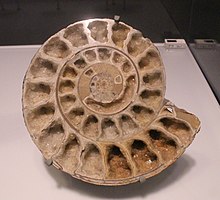Apoderoceras is an extinct genus of cephalopod belonging to the ammonite subclass.
| Apoderoceras Temporal range:
| |
|---|---|

| |
| Fossil specimen at Field Museum of Natural History | |
| Scientific classification | |
| Domain: | Eukaryota |
| Kingdom: | Animalia |
| Phylum: | Mollusca |
| Class: | Cephalopoda |
| Subclass: | †Ammonoidea |
| Order: | †Ammonitida |
| Family: | †Coeloceratidae |
| Genus: | †Apoderoceras Buckman, 1921 |
| Species[2] | |
| |
Ammonites (Apoderoceras) were predatory mollusks that resembled a squid with a shell. These cephalopods had eyes, tentacles, and spiral shells. They are more closely related to a living octopus, though the shells resemble that of a nautilus. True ammonites appeared in the fossil record about 240 million years ago. The last lineages disappeared 65 million years ago at the end of the Cretaceous.[3]
Biostratigraphic significance
editThe International Commission on Stratigraphy (ICS) has assigned the First Appearance Datum of genus Apoderoceras and of Bifericeras donovani the defining biological marker for the start of the Pliensbachian Stage of the Jurassic, 190.8 ± 1.0 million years ago.
Distribution
editJurassic of Argentina, Hungary, Italy, Portugal, the United Kingdom [4]
References
edit- ^ Sepkoski, Jack (2002). "Sepkoski's Online Genus Database". Retrieved 2014-05-28.
- ^ "Apoderoceras". Paleobiology Database. Retrieved 29 April 2022.
- ^ https://www.fossilera.com/fossils/huge-13-spiny-jurassic-ammonite-apoderoceras-fossil-england
- ^ "Paleobiology Database". Retrieved 17 December 2021.